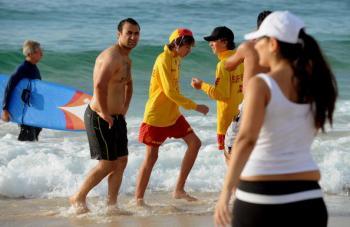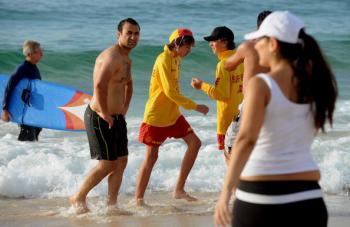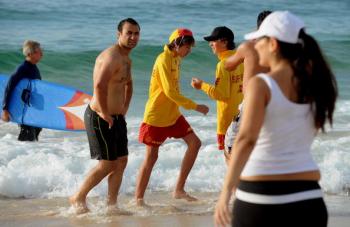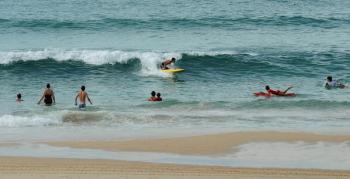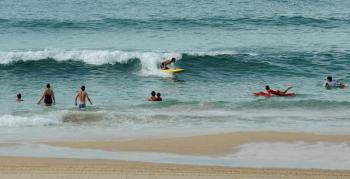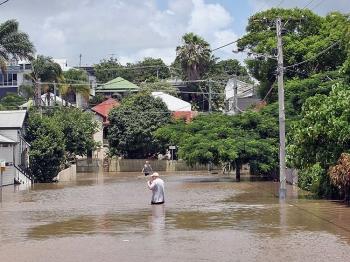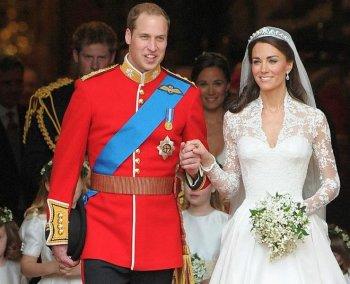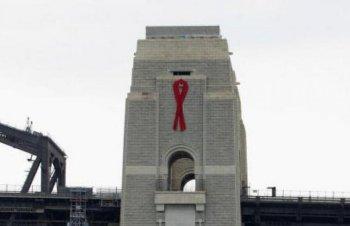SYDNEY—The tsunami warning that went out for the east coast of Australia on Sunday Feb 29 was luckily harmless, but there will need to be better education and more information in the future, says Chris Ryan, co-director of the Joint Australian Tsunami Warning Centre (JATWC).
“There is no doubt, we need to do more work as the message did not filter through the media,” Mr Ryan told The Epoch Times.
The JATWC, which was formed as a result of the Boxing Day tsunami in 2004, is jointly operated by the Bureau of Meteorology (Bureau) and Geoscience Australia (GA), but also works with the State Emergency Services and Surf Lifesaving Australia.
The tsunami warning centre issued a low-level tsunami warning on the Sunday morning, stating that strong ocean currents triggered by rising sea levels could be expected.
The warning came following the massive 8.8 magnitude Chile earthquake, but many people ignored surf lifesavers, swimming as usual on what was a perfect last day of summer.
Mr Ryan said people who ignored the warnings and went into the water did not understand the risks.
Although massive waves were not predicted, currents and rips are more unpredictable during a tsunami effect. He said: “Those that feel they know the rips and currents on their beach are most vulnerable. A tsunami will take them by surprise.
“The waves have a lot of force–long waves with a lot of water behind them.”
There was also some misunderstanding about the duration of the risk, Mr Ryan said, with many expecting the first waves to be bigger with subsidence as the afternoon progressed.
“It is not just the first waves, but a series of waves, up and down for many hours,” he said.
“The largest waves yesterday occurred in the afternoon,” he said.
Warnings went out across the Asia-Pacific the moment the Chile earthquake was registered.
Japan, which had lost 140 people in a tsunami from a 9.5 magnitude earthquake in Chile in 1960–the largest on record–experienced the worst effects from the quake, registering 2.5m waves and some coastal flooding. This time, however, they were better prepared.
Japanese authorities ordered the evacuation of over 70,000 people, sirens blared up and down the coast, massive steel gates were slammed shut across the entrances to several fishing ports and coastguard vessels combed the seas to search for stray ships.
Travelling at over 700km/hr, the waves raced across the Pacific, also threatening French Polynesia where sirens also wailed and PA systems alerted residents to move away from the coast.
Huge waves struck the Gambier archipelago at 6.30am (0330 AEDT), AFP reported, and in Tahiti, all traffic was banned within 500m of the coast. In The Marquesas Islands north-east of Polynesia, a series of 2-metre waves damaged boats, while between the waves, the sea withdrew around 15m, causing rip currents.
“There is no doubt, we need to do more work as the message did not filter through the media,” Mr Ryan told The Epoch Times.
The JATWC, which was formed as a result of the Boxing Day tsunami in 2004, is jointly operated by the Bureau of Meteorology (Bureau) and Geoscience Australia (GA), but also works with the State Emergency Services and Surf Lifesaving Australia.
The tsunami warning centre issued a low-level tsunami warning on the Sunday morning, stating that strong ocean currents triggered by rising sea levels could be expected.
The warning came following the massive 8.8 magnitude Chile earthquake, but many people ignored surf lifesavers, swimming as usual on what was a perfect last day of summer.
Mr Ryan said people who ignored the warnings and went into the water did not understand the risks.
Although massive waves were not predicted, currents and rips are more unpredictable during a tsunami effect. He said: “Those that feel they know the rips and currents on their beach are most vulnerable. A tsunami will take them by surprise.
“The waves have a lot of force–long waves with a lot of water behind them.”
There was also some misunderstanding about the duration of the risk, Mr Ryan said, with many expecting the first waves to be bigger with subsidence as the afternoon progressed.
“It is not just the first waves, but a series of waves, up and down for many hours,” he said.
“The largest waves yesterday occurred in the afternoon,” he said.
Warnings went out across the Asia-Pacific the moment the Chile earthquake was registered.
Japan, which had lost 140 people in a tsunami from a 9.5 magnitude earthquake in Chile in 1960–the largest on record–experienced the worst effects from the quake, registering 2.5m waves and some coastal flooding. This time, however, they were better prepared.
Japanese authorities ordered the evacuation of over 70,000 people, sirens blared up and down the coast, massive steel gates were slammed shut across the entrances to several fishing ports and coastguard vessels combed the seas to search for stray ships.
Travelling at over 700km/hr, the waves raced across the Pacific, also threatening French Polynesia where sirens also wailed and PA systems alerted residents to move away from the coast.
Huge waves struck the Gambier archipelago at 6.30am (0330 AEDT), AFP reported, and in Tahiti, all traffic was banned within 500m of the coast. In The Marquesas Islands north-east of Polynesia, a series of 2-metre waves damaged boats, while between the waves, the sea withdrew around 15m, causing rip currents.
Tsunami Prediction
Mr Ryan said there was still much work to be done to better predict the size of a tsunami as it heads towards Australia and the specifics of places that are most likely to be impacted.
The calculations were complex and based on a number of variables, including the type, magnitude and position of the quake, the shape of the fault line and readings from deep sea buoys, he said. The original JATWC tsunami warning from the Chile earthquake, for example, had not been broad enough.
“The deep ocean buoys had picked up movement further south than we had estimated so we had to adjust accordingly,” he said.
Tasmania and Eden along with the Gold Coast in the north experienced between a 20 and 25cm rise in sea levels.
Geoscience Australia is presently working on detailed studies to predict and plan for areas in Australia that are most vulnerable to “inundation” (flooding) from a tsunami, but that work is time consuming, expensive and a slow process, he said, adding: “Having said that, the information is gradually being put together so that plans can be made accordingly.”
The calculations were complex and based on a number of variables, including the type, magnitude and position of the quake, the shape of the fault line and readings from deep sea buoys, he said. The original JATWC tsunami warning from the Chile earthquake, for example, had not been broad enough.
“The deep ocean buoys had picked up movement further south than we had estimated so we had to adjust accordingly,” he said.
Tasmania and Eden along with the Gold Coast in the north experienced between a 20 and 25cm rise in sea levels.
Geoscience Australia is presently working on detailed studies to predict and plan for areas in Australia that are most vulnerable to “inundation” (flooding) from a tsunami, but that work is time consuming, expensive and a slow process, he said, adding: “Having said that, the information is gradually being put together so that plans can be made accordingly.”
